The Process of Evolution by Natural Selection
- Evolution requires that allele frequencies change with time in populations
- Evolution is defined as the cumulative change in the heritable characteristics (genes) of a population over time
- Organisms cannot change their species' phenotype significantly without an underlying change in their genetic makeup
- The factors that drive evolution are
- Mutations causing new alleles to come into being
- Selection pressures that favour the existence of certain alleles and oppose that of others
- A key consideration is that evolution has no purpose
- There is no conscious change of genetic makeup in order to take advantage of changes in conditions
- Mutations and selection pressures occur entirely at random
- A species only evolves by virtue of a lucky combination of advantageous alleles and selection pressures
- Organisms developing other alleles that put an affected individual at a selective disadvantage will not survive to reproduce and pass on those alleles
- Changes in allele frequencies can sometimes be referred to as genetic drift
- Evolution can happen within a species before speciation occurs
- An example is the many dog breeds that all exist within the same species, Canis familiaris
- Whilst many breeds have been selectively bred artificially for aesthetic reasons by humans (or to perform valuable tasks like seeing-eye dogs), most common dog breeds are capable of interbreeding to produce fertile offspring, often referred to as mongrels
- Population size has an effect on evolution
- In a small population, random events such as climate change can have a dramatic effect on the frequency of alleles
- By contrast, in a large population, there is more capacity to absorb small fluctuations in allele frequency
- When an allele is put under selective pressure, its frequency drops and sometimes falls to zero as a more advantageous allele becomes more abundant, or becomes the only allele in the gene pool
Example of changes in allele frequency driving evolution
- The peppered moth (Biston betularia) is a well-documented case study of evolution by natural selection
- In the early 18th century in the northern UK, the light grey-winged form of this moth prevailed
- These moths were well-camouflaged against the light-coloured bark and lichens of their host tree species
- Black-winged moths (which carried the allele for melanism) fared badly as they were easy for predators (mainly birds) to spot against the light background
- During the industrial revolution (mid-late 18th Century), soot from coal-burning factories and house chimneys coated many of the trees in the area, turning them dark or black
- This led to an increase in predation of light-winged (non-melanistic) moths whose camouflage was no longer so effective
- The dark-winged moths became the predominant variety as the frequency of the melanism allele increased over successive generations of moths
- Analysis of the populations throughout this period revealed the following changes in allele frequency
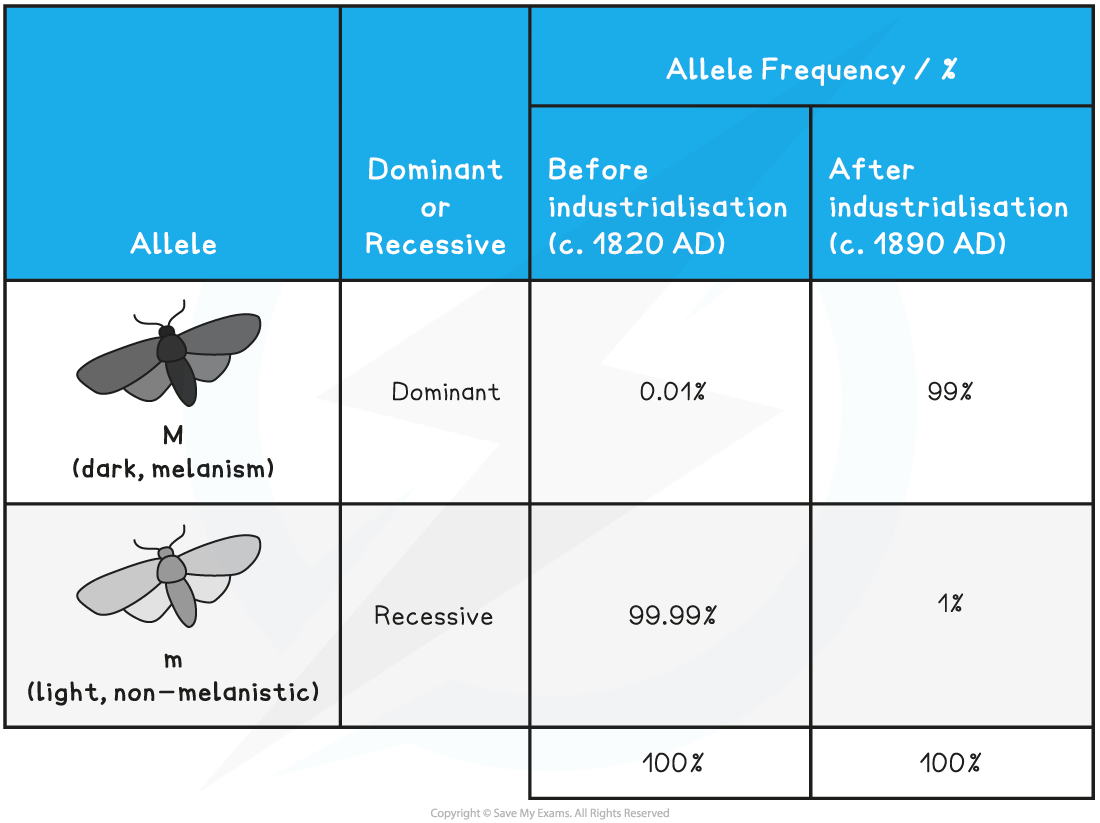

Exam Tip
Avoid confusing allele frequency with phenotype frequency; these are different. In a case where the allele frequency of a recessive trait is 0.4 (40%), this means that the dominant allele must occupy 60% of the gene loci for that gene. The phenotype frequency of the recessive trait will in fact not be 40% because two copies of the recessive allele need to combine through fertilisation for the recessive trait to be expressed. The phenotype frequency will therefore be 0.42 which is 0.16 (16%). Only 16% of the population will express the recessive trait whereas 40% of the gene loci in the population contain the recessive allele.
Types of Natural Selection
- There are three main types of selection:
- Directional
- Stabilising
- Disruptive
Directional selection
- The population changes towards one extreme of a range of variation
- As that extreme becomes better adapted
- This tends to happen when environmental conditions change
- For example, a fall in average temperatures can affect plants that are not resistant to frosts (spells where the air temperature falls below 0°C)
- If there is no allele that can give the species a degree of frost resistance, then the species will become extinct in that habitat if cold temperatures endure for more than one generation
- If an allele exists that gives a degree of frost protection, then the species will be able to
- Survive the frost
- Go on to reproduce successfully
- Such an allele may code for a new protein that can lower the freezing point of water/cell contents by a few degrees and prevent the formation of damaging ice crystals
- The species has developed a selective advantage over other species
- A disadvantageous allele does not have to be fatal to an individual organism
- However, it must prevent the individual from reproducing successfully
- Which is effectively the same thing from an evolutionary point of view
- Because the allele will disappear from the gene pool as the reproductively unsuccessful individuals die
- The species can change its genome abruptly by directional selection

Directional selection acting on fish body size. Increases in ocean temperatures are selecting for smaller body sizes in fish. Warmer seas cause fish metabolism to speed up and so increase their need for oxygen (oxygen levels are lower in warmer seas). Larger fish have greater metabolic needs than smaller fish, and so they feel the effect of increased temperatures more strongly.
Stabilising selection
- Selects in favour of the average individual in a population
- Occurs when environmental conditions are stable / do not change
- Selection tends to favour individuals with a range of alleles whose characteristic is the most advantageous
- Stabilising selection is the most common form of natural selection
- An example is the coat colour of mice
- The colour stabilises as the one which gives the most camouflage against the surroundings eg. brown fur versus a forest floor
- Birth mass is also an example
- Where a normal distribution clusters around a mean birth mass
- Too low and too high can lead to problems of survival for an infant
- Stabilising selection
- Discards extreme phenotypes
- And instead favours the majority of the population that is well adapted to their local environment
- Decreases diversity within a population
- Works mostly on traits that are polygenic
- Is often characterised by a normal distribution (a bell-shaped curve)
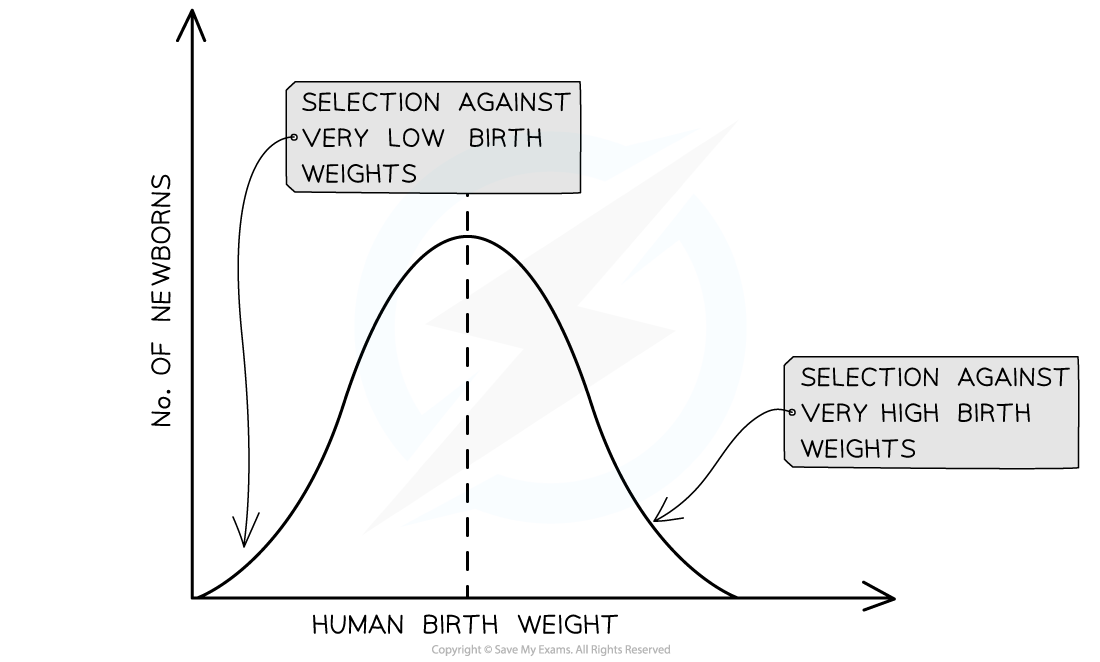
Stabilising selection on human birth weight.
Disruptive selection
- Selects against the average individual in a population
- Is the rarest of the three forms of natural selection
- Like directional selection, disruptive occurs when habitats or resources undergo a change
- Disruptive selection can lead to the formation of an entirely new species (speciation)
- For this reason, is sometimes referred to as 'diversifying selection'
- Darwin's finches in the Galápagos Islands are one of the best-known examples
- Fifteen different species evolved from a common ancestor
- Multiple types of beaks have adapted to different food sources over time
- On one island, Santa Cruz
- Ground finches eat more seeds and some arthropods
- Tree finches eat more fruits and arthropods
- Vegetarian finches feed on leaves and fruit
- Warblers typically eat more arthropods
- When food is abundant, their diets can overlap
- When food is scarce, these specialisations give each species the ability to compete for a certain type of food better than other species
- This helps each species to occupy its own niche
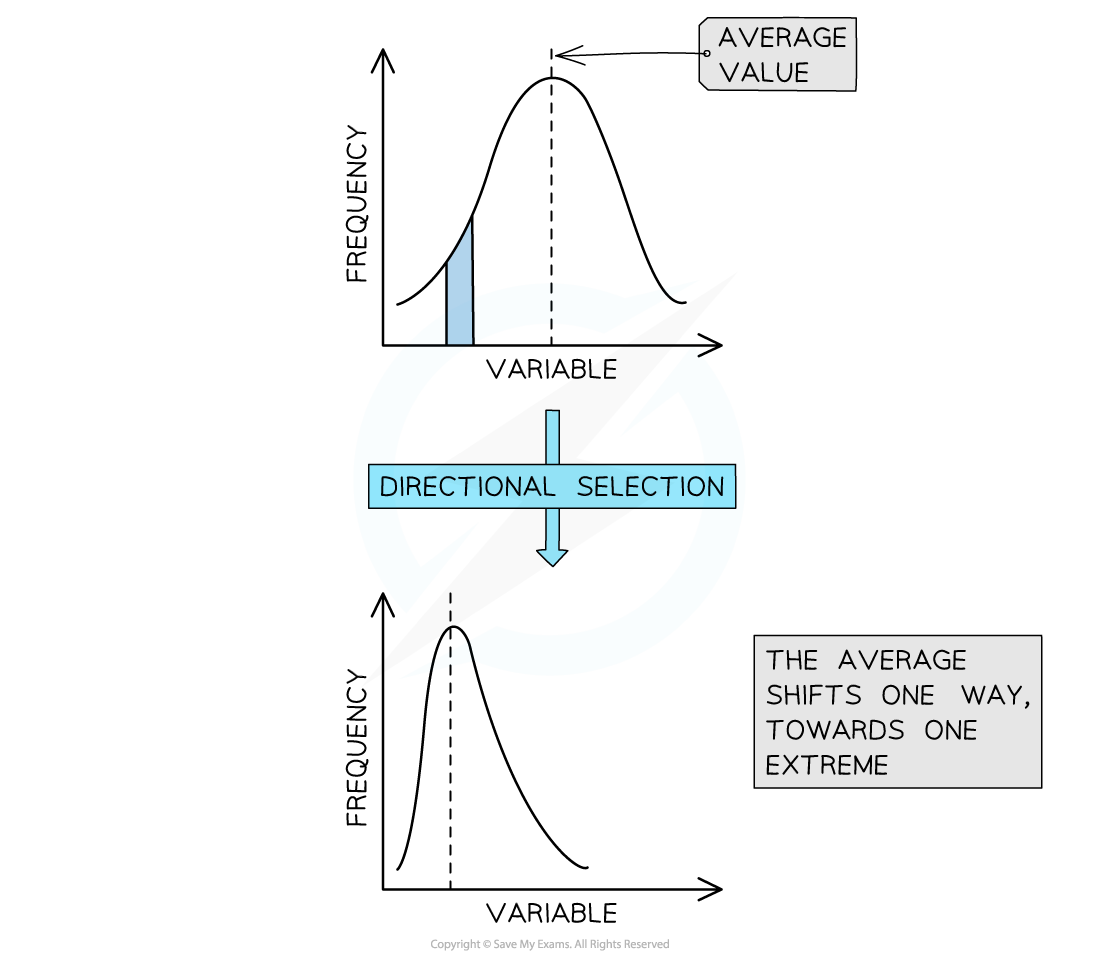
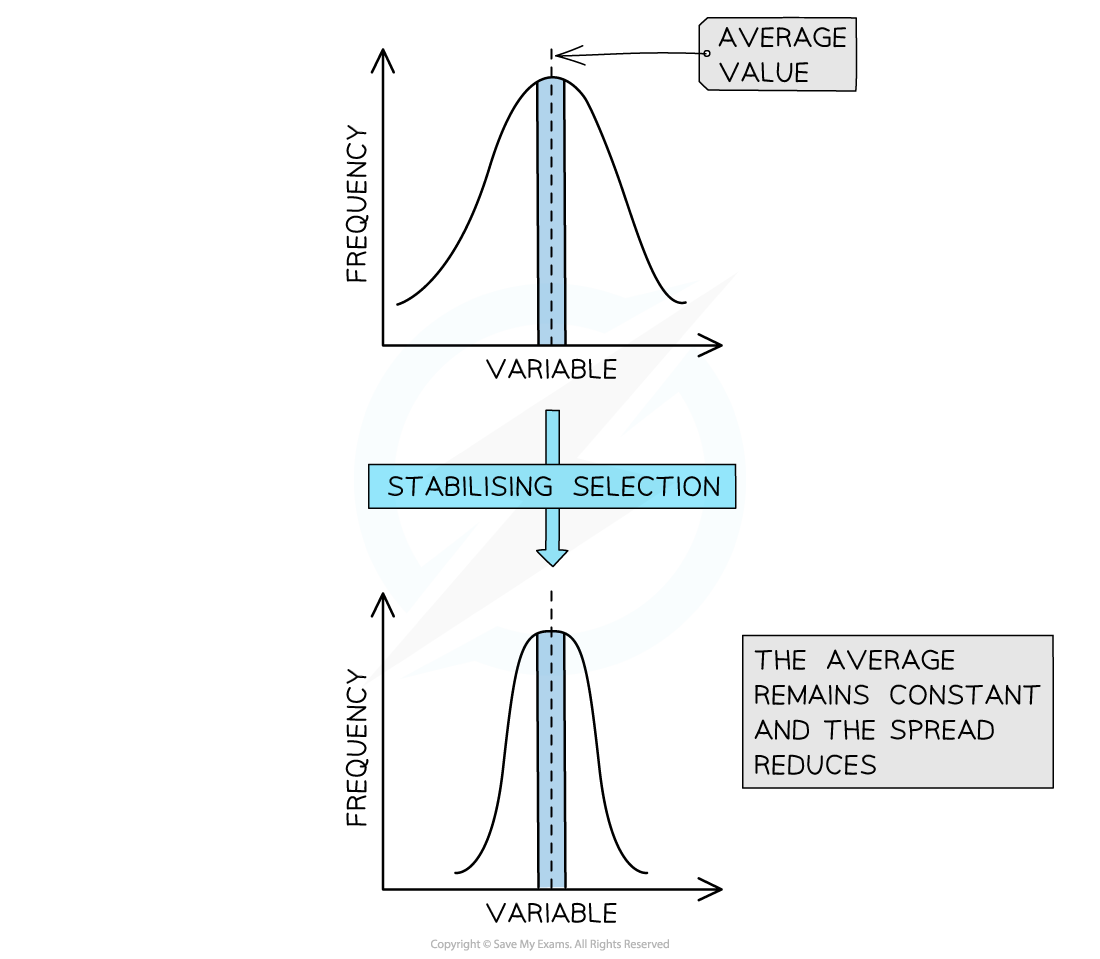

Summary of the 3 main forms of natural selection and their effects on the average phenotype of a population

Disruptive selection acting on beak size in a bird population
Exam Tip
Become familiar with the shapes of the graphs above. They can help you answer questions about the type of selection that is occurring in a population.
Reproductive Isolation
- Reproductive isolation of populations can be temporal, behavioural or geographic
- A population of a species can become isolated from its peers by various means
- A barrier forms, meaning no interbreeding occurs between the two populations
- For many generations, there may be little or no variation of the gene pool within that population
- The nature of the barrier between populations can be temporal, behavioural or geographic
- Temporal (ie. seasonal)
- Different groups have reproductive cycles at different times of the year so cannot interbreed
- eg. Changes in flowering patterns of plants in different seasons
- Behavioural
- Different groups have different rituals or patterns of behaviour meaning that the groups do not recognise each other as 'self'
- eg. Courtship rituals
- Geographical
- eg. When natural or man-made barriers form between two parts of a population, such as a river, freeway, or mountain range
- Temporal (ie. seasonal)
- Over a longer period, the formation of new species (speciation) occurs by reproductive isolation ie. separating parts of the population into independently-breeding groups
- Natural selection will take different paths according to the differences of biotic and abiotic factors on either side of the divide
Sympatric vs allopatric speciation
- Temporal and behavioural speciation are both examples of sympatric speciation, in which separately-developed species can coexist in the same geographical area whilst occupying different niches
- Geographic speciation is sometimes called allopatric speciation, in which two separate species diverge with complete spatial separation
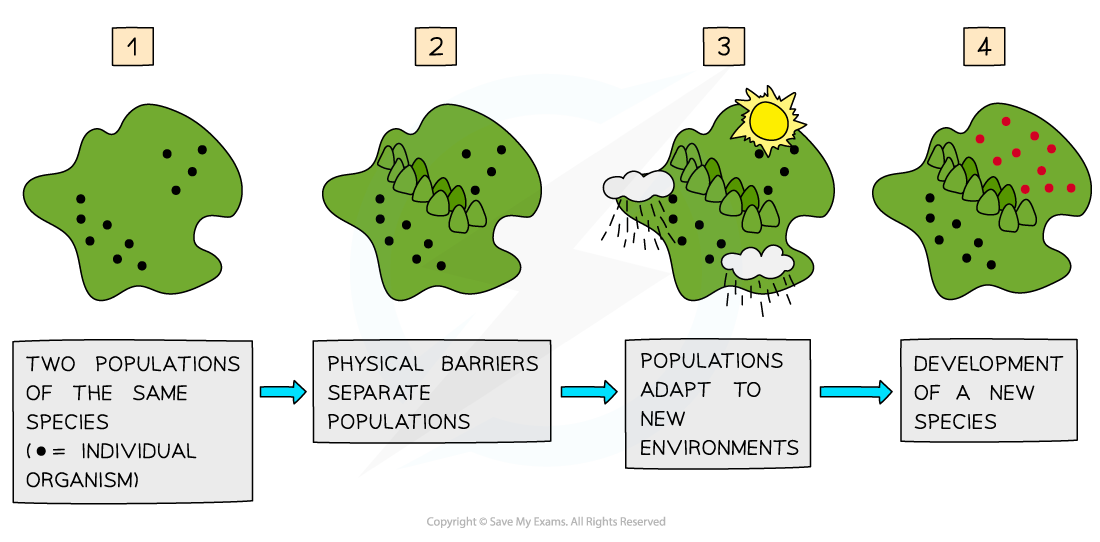
Geographical isolation can lead to speciation.
Exam Tip
A typical exam question will ask you to identify which form of natural selection is taking place from a set of data in the question. Alternatively, you may have to give reasons from the data about why a particular example of natural selection is identified as one of the three forms. Think about how the 'average' individual in a population is affected and that will lead you towards the correct answer.
